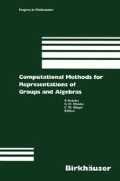Abstract
The construction of representations of Lie groups is intertwined with combinatorics. For instance the combinatorial Littlewood-Richardson rule tells us how the tensor product of two irreducible GL n -representations W 1 and W 2 decomposes into irreducibles, provided n is big with respect to the size of the Young diagrams corresponding to W 1 and W 2. Moreover, each irreducible GL n -representation occurs in a tensor power V ⊗dof the natural representation V and can be isolated by use of combinatorics of the symmetric group S d acting on V ⊗d by permuting the d factors. The intriguing part of the latter two combinatorial involvements is that they hardly depend on the series parameter n. For instance, once the primitive idempotents of the enveloping algebra of S d inside End(V ⊗d) are figured out, the irreducible components of V ⊗d for GL n follow (again, at least for n sufficiently large).
Access this chapter
Tax calculation will be finalised at checkout
Purchases are for personal use only
Preview
Unable to display preview. Download preview PDF.
Bibliography
A.M. Cohen and R. de Man: Computational evidence for Deligne’s conjecture regarding exceptional Lie groups, C.R. Acad. Sci. Paris 322 (1996), série I, 427–432.
P. Cvitanović: Group Theory, Part II: Exceptional Lie groups, preprint, 1984–1997.
P. Deligne: La série exceptionnelle de groupes de Lie, C.R. Acad. Sci. Paris 322 (1996), série I, 321–326.
P. Deligne and R. de Man: La série exceptionnelle de groupes de Lie II, C.R. Acad. Sci. Paris 323 (1996), série I, 577–582.
P. Deligne and J.S. Milne: Tannakian categories, in: Hodge cycles, Motives and Shimura Varieties, volume 900 of Lecture Notes in Math., 101–228, Springer-Verlag, Berlin, 1982.
M. El Houari: Nouvelle classification des (super) algèbres de Lie simples par le biais de leurs invariants tensoriels, Thesis, Université de Paris Sud, Centre d’Orsay, 1994.
S. Mac Lane: Categories for the Working Mathematician, volume 5 of Graduate Texts in Math., Springer-Verlag, New York, 1971.
R. Penrose: Applications of negative dimensional tensors, in: Combinatorial mathematics and its applications, ed. D.J.A. Welsh, Academic Press, New York, 1971.
P. Vogel: Algebraic structures on modules of diagrams, preprint, 1995.
H. Weyl: The Classical Groups, Princeton Math. Ser. 1, Princeton University Press, 1946.
Editor information
Editors and Affiliations
Rights and permissions
Copyright information
© 1999 Springer Basel AG
About this paper
Cite this paper
Cohen, A.M., de Man, R. (1999). On a Tensor Category for the Exceptional Lie Groups. In: Dräxler, P., Ringel, C.M., Michler, G.O. (eds) Computational Methods for Representations of Groups and Algebras. Progress in Mathematics, vol 173. Birkhäuser, Basel. https://doi.org/10.1007/978-3-0348-8716-8_6
Download citation
DOI: https://doi.org/10.1007/978-3-0348-8716-8_6
Publisher Name: Birkhäuser, Basel
Print ISBN: 978-3-0348-9740-2
Online ISBN: 978-3-0348-8716-8
eBook Packages: Springer Book Archive

